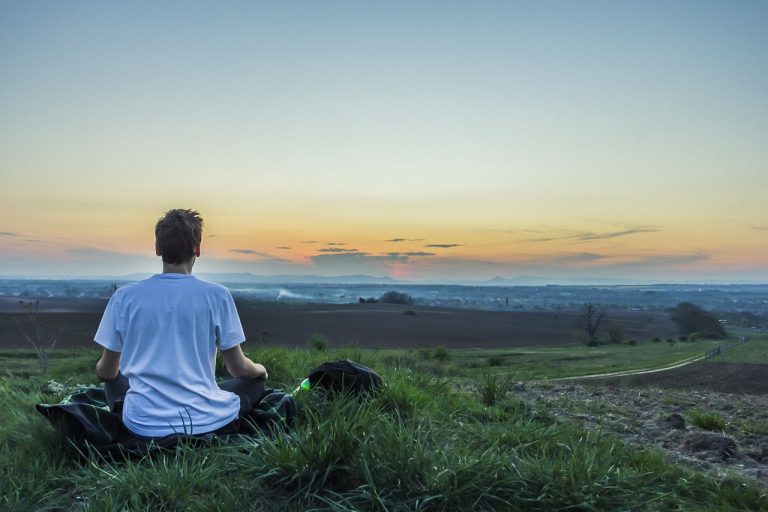How to meditate daily? (Quick & effective Steps)
Table of Contents
What is meditation
Before knowing how to meditate daily? We must know what meditation is and what we are trying to achieve. Experts throughout the world don’t have the same opinion over the definition of meditation. But it is conceptualized as an approach to train your wandering mind using different techniques to encourage a more excellent state of awareness and focus and an end goal of mental clarity and stability.
In experts words, essential criteria to practice any meditation is to:-
- Have defined set of techniques
- Logic or cognitive relaxation
- A self-induced state of heightened awareness
- Psycho-physical relaxation
Mediation has a vibrant history all over the world, in all recognized religions. Wall arts document meditative practices in Hinduism, where we can see people sitting in specific postures with half-closed eyes. Vedas and Upanishads contain a lot of information about ancient Hindu meditation practices. It is also found in Buddhism and Taoist religions in China. In the West, Philo of Alexandria documented different forms of spiritual exercises which involved concentration and attention. Plotinus developed many helpful meditation techniques. Experts believe Judaism inherited mediation through tradition.
How to meditate?

Ancient vs. modern meditation:-
Ancient meditation practices were more religious. The motive behind meditation used to gain focus and to connect to higher spiritual power, to remove all the ignorance and gain knowledge or get enlightened and to unite and submit our soul to the absolute. This type of meditation required tranquil and religious places, and the Vedic age lifestyle supported this. It required strict postures and many other sacred pieces of equipment like candles and incense sticks. In the Bramhachari phase of life, young boys used to stay in their teacher’s ashram and learned meditation along with receiving education.

While modern meditation is more for personal goals like becoming a better person, a focus or calmed mind to be more productive, to stop inner distractions and to know oneself better, to manage emotions, to achieve mindfulness, etc. It is more relaxed and no strict postures, though some poses are preferred.
Daily meditation
Types of meditation:-
Before knowing how to meditate, let’s check out the different types of meditation available for any beginner to practice. Those types are one of or the combination of concentration, observation and awareness. These are:-
- Focus meditation :- People practice this technique to achieve better focus to help us in our daily lives. It’s different from classical meditation practices, where we try to gain a state of nothing in our mind. Here we intently focus on only one thing; it can be a particular sensory stimulation, something visual like a circle in the wall, some smells or taste, etc. It can be frustrating for beginners as it is natural to lose focus. Remember it’s normal, and do not let it demotivate you.
- Mindfulness meditation :- It’s a beneficial technique to calm down our wandering mind and to shut down our inner distractions, negativity, worries, and to focus on now. It involves a deep breath. You will have to be aware of present in a non-judgmental state of mind. Feel how your belly is going up and down while you are inhaling and exhaling; get yourself comfortable and notice how your body is feeling. Let your thoughts creep in, and let it slide through you like clouds. It needs no rituals or preparations.
- Movement meditation :- It is also known as dynamic or active meditation. It is very different from classical meditation, where comfortable sitting is required to calm your mind. In dynamic meditation, be completely aware of various movements of your body and the change of sound, sight, and other physical sensations with it. Suppose you are running. Try to feel the surface of the road through your shoes, feel the air in your hand, etc. In this way, it helps us to focus on the present moment. This meditation is beneficial for restless people who are unable to sit in a position quietly.
- Mantra meditation :- It is the most ancient form of meditation. People used to chant mantras which are phrases or words, can be long or short, having religious means, often praising gods and goddesses, and repeated throughout the meditation. But you don’t have to chant Vedic mantras, and you can randomly choose a word and can chant. This type of meditation helps beginners as it becomes a little bit easier to focus on the phrases. You can select a random word or positive affirming phrase as your mantra, which matches your goals. Choose a quiet place and avoid overstimulation. You can continue as you please.
- Zen meditation :- It’s also known as Zazen and is rooted in Buddhism. Its goal is to regulate our attention and practice “thinking about not thinking. Its posture is the same as Padma-asana‘s posture and is focused inwardly. It is an open-monitoring meditation, where the technique is to monitor something, preferably count of breath. It is similar to mindfulness meditation, but it focuses on general awareness rather than focusing on a particular object. It helps us to get better perception and clarity of thoughts.
- Progressive meditation :- This technique helps to calm not only our mind but also our body. It is done by tensing and relaxing every group of muscles, one at a time. It helps a lot when you are tensed or anxious. Experts believe that it helps with insomnia, so you can try it to fall asleep.
- Love-kindness meditation :- This meditation invokes empathy, compassion, love, and kindness in oneself. Take some time for yourself and allow yourself to be non-judgemental. Imagine a feeling of love and warmth for yourself and others whom you choose and set a very benevolent intention at heart.
- Visualisation meditation:- This meditation used visualization to focus your mind on something. This technique can be compelling if we learn to control our visualization and reinforce the neural pathways. Experts say sometimes visualization strengthens the muscle memory even if we aren’t doing that physical, and this strategy helps athletes a lot.
Now, you are familiar with different types of meditation. You may feel frustrated with a kind of meditation. Without losing hope, you can try any other from the list. But as a beginner, how to choose?
Question yourself, why you thought of meditating in the first place. Is it because of a lack of focus? Do you want to be more mindful? Or maybe you want to calm yourself down. Once you get the answer, you can figure out what type will suit you well.
When, where, and how to meditate daily?
Time of meditation: Take out some time from your daily life when you are primarily free of work. Now, this may be the first thing early in the morning or before you go to bed at night. There is no fixed time for when to meditate; it depends on when you are most comfortable. If you are a morning person starting your day with meditation may give you an extra boost of energy for the rest of the day. Whereas if you’re a night person, you may meditate before going to sleep for relaxation.
Place of meditation: It is always advisable to find a peaceful place free of distraction and noise for meditating. But also, there is no designated place for meditation. It can be your room, or it may be a neighborhood park. Also, if you are doing walking meditation, you may take a walk during the least busy part of the day. You may want to meditate outside your bedroom if you tend to fall asleep during meditating because your brain associates bed with sleep. For that, any other part of the house is suitable for your meditation.
Posture during meditation: For beginners maintaining a specific posture might be a little tricky, but you will get there with time. The best posture for meditation is when you are seated. Avoid lying down since you may fall asleep, which isn’t the goal of meditation. You may sit in the lotus form, or if that’s not comfortable for you, you may sit on a chair. No matter how you sit, remember to keep your spine straight. If you tend to slouch, remind yourself to sit up straight, or you may sit in the diamond pose since it’s much easier to keep your spine straight in this position.
Keep your hands relaxed and on your knees. Try to keep your shoulders upright but relaxed. Also, keep your jaw relaxed and unclenched. For a beginner, you may find keeping your eyes closed is easier. At the same time, meditation, but you may try visual meditation in which you focus your gaze on a particular object or the surroundings or the flame of a candle.
Tips on how to meditate daily and make it a habit:-
- Set alarms: Try to meditate at a specific time so that it turns into a habit. For that, set alarms to remind you to focus.
- Track your journey: Download a tracker app with an in-built alarm function to help you form a habit.
- Take small steps: If you find you have trouble concentrating continuously for 5 minutes at a time, take it slow. Try meditating for a minute and gradually increase your attention span along with time.
- Journal: If you find sitting at a place for minutes difficult, you may try writing down about your day as a form of meditation.
- Set a timer: Setting a timer will help you not to wonder how much time has passed and repeatedly check the clock. After setting the timer, it will assure you that you will be notified and focus on meditating.
- Try breathing meditation: With all these different types of meditation, you may feel overwhelmed and confused about which one to try. Try the simplest form in which you count your breathing.
- Accept that the mind wanders: In the beginning, you may find it challenging to focus and your mind wandering. Please don’t beat yourself up for it. The purpose of meditation is to stop the mind from wandering. Whenever you feel yourself deviate from the focus, bring yourself back.
- Let your thoughts flow: Don’t restrict your thoughts or guide them in a particular direction. If a distraction comes, acknowledge it and let it flow on its own don’t ponder over it.
Benefits of meditation:
- Helps to reduce stress: Stress reduction is the most common benefit reaped from daily meditation. Stress increases levels of cortisol which causes harmful effects such as irregular sleep, high blood pressure, and fatigue. A study has found that meditation reduces stress-related symptoms such as post-traumatic stress disorder and fibromyalgia.
- Lengthens attention span: Studies show that people who regularly practice meditation have a better work efficiency and a longer attention span than those without any meditation experience.
- May help in age-related memory loss: Meditation shows that it partially increased memory in dementia patients. Meditating from a young age helps in keeping the brain young since it increases attention span.
- Might help with addictions: Meditation induces a mental discipline which in turn may help in increasing self-control and fighting addictions. Research has shown that meditation may help people in impulse control and alcohol addiction. Meditation may also help in binge eating.
- Better sleep: Meditation can relax your body, helping with tensions and making it easier to fall asleep. Meditation can also help people with insomnia by relaxing the mind and reducing unnecessary thoughts.
- May help in high blood pressure: Meditation reduces strain on the heart. Constant high blood pressure leads to narrowing the arteries, leading to heart attack and stroke. Studies show that regular meditation helps in controlling blood pressure and reduces its effects
- Helps in emotional health: Meditation helps to find your inner peace and helps you grow into your best version. Regular meditation helps you recognize harmful thoughts and helps you form more constructive thought patterns. Meditation can also help improving self-image and help you become more positive. Mindfulness increased symptoms of depression and anxiety.
Final Thoughts
You may be inconsistent when starting meditation, you may not meditate daily and maybe not at the fixed time, but that’s completely alright as long as you don’t completely abandon it. You have to gradually build a habit so that meditation doesn’t feel like an extra chore. With all the benefits of meditation reaps, you may want to start meditating from today onwards!



